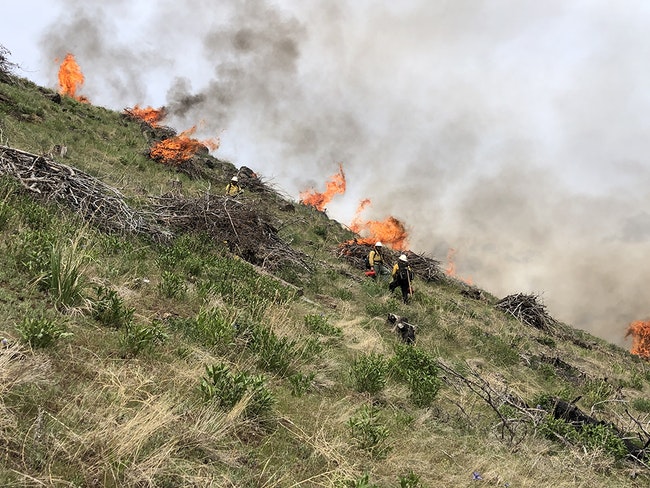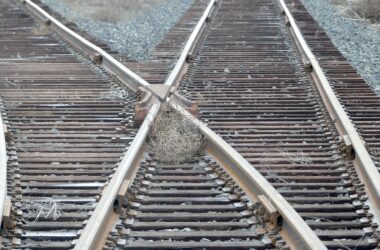
A Bureau of Land Management fire crew conducts pile burning of cut juniper at Hunter Mountain, north of Juntura, on May 13. (The Enterprise/Photo Courtesy of BLM)
Fire season is underway in Malheur County, and the Vale District of the Bureau of Land Management has already responded to a number of recent fires.
The Vale BLM is expecting a much more active and severe fire season than in 2019, said Al Crouch, fire mitigation and education specialist in Vale. The BLM began to see fires in the Vale District in May, and the area is on track for a dry year, Crouch said.
While the dryness has slowed down due to recent rain, he said hotter weather can rapidly change that.
He said it was too early to predict the fire potential in the Vale District this summer.
The 2019 fire season was well below average for Malheur County, Crouch said, with a decrease in all forms of fires.
“Last year, it was wetter and greener,” he said. “This year, we’re not expecting that at all. We’re expecting it to be hot and dry.”
The next three weeks will be critical to determine moisture content in range fuels, such as grasses.
Those fuel conditions will depend on the amount of lightning, how much moisture comes with it and what people do to prevent wildfires, Crouch said.
Fuel is measured in four classes, with the highest being found typically in larger logs, he said, and it is indicative of long-term drought. This dead fuel level was above average entering June in the Northwest and well above it in eastern Oregon, which will likely see drier than average precipitation between June and September, according to a Wildland Fire Potential Outlook from the National Interagency Fire Center issued June 1.
Increased moisture leads to grass growth, creating fuel for wildfires, while dry conditions will cause brush fields to dry out faster – both posing risks for fire potential, Crouch said.
Flashy fuels can increase more quickly in taller, dried grass than timber in forests, said Jennifer Smith, spokesperson for the National Interagency Fire Center.
There has been early drying along the river corridors, which have recently drawn abnormally high recreational use, Crouch said. The combination “makes for a potentially bad mix for wildfires,” he said, and fires have already occurred in those areas.
The Vale BLM has responded to six human-caused fires this year and a few lightning fires, but those do not include fires under the jurisdiction of a fire department or district, or the rangeland fire protection associations, he said.
About 30% of fires on Vale BLM-administered lands are human-caused, with the rest being a result of lightning. Of the human-caused fires, 70% are caused by some form of equipment, he said.
Nationally, humans cause an average of 87% of wildfires every year, according to a set of “Talking Points” from the NIFC.
In the rangeland, wildfires mostly occur as a result of lightning when there are sparks in dry land, said Tamara Cannon, secretary of the Vale Rangeland Fire Protection Association.
Crouch advised that people should check equipment to ensure it works properly and doesn’t produce sparks, keep vehicles off of dry grass — especially in low elevations — and check regulations. He recommended calling the BLM office, as well as visiting its website or the Blue Mountain Interagency Dispatch Center website for information about current fire restrictions in eastern Oregon.
The Vale BLM has seen more shooting-caused fires, he said, which people can help mitigate by following the fire prevention order prohibiting tracer ammunition, incendiary ammunition and exploding targets and fireworks on BLM lands. He also advised against shooting hard targets, trash or anything metal.
“Just exercise good shooting ethics — shoot safely, pick up trash and enjoy yourself,” Crouch said.
The BLM has also seen a spike in the number of unattended or abandoned campfires in the Vale District, which is both a threat for causing wildfires and a violation that is subject to a fine, said Crouch. He urged campers to keep their fires attended, ensure that the area around a campfire is clear of flammables up to 10 feet, keep fires small and contained with a metal or rock ring, don’t burn when it is windy and “make sure your fire is dead out before you leave.”
Crouch also said it is critical that landowners and homeowners do their part in helping prevent wildfires. Embers can collect and ignite on roofs and in gutters, as well as enter unscreened openings around houses, according to a May 4 news release from Oregon State Fire Marshal Jim Walker.
“Keep your roofs, gutters and eaves clear of all leaves, pine needles and other flammable debris,” Walker said.
Fire officials “suggest removing dead vegetation a minimum of 30 feet around homes and other structures,” as well as pruning trees and keeping grass short and green to help ensure that potential fires are close to the ground and more manageable for fire crews, the news release said.
“Defensible space is a property’s first line of defense against wildfire,” said Tom Fields, Oregon Department of Forestry fire prevention coordinator, in the news release.
The National Fire Protection Association webpage offers useful information to help homeowners prepare for wildfires, Crouch said.
The BLM is adjusting its training and fire response for firefighters in light of the COVID-19 pandemic, according to the NFIC document. The changes include considering using more vehicles to move crews and having firefighters operate in smaller groups to allow for social distancing.
“While fire organizations will do their best to follow CDC guidelines, in some cases, fire personnel will not be able to safely suppress wildfires and follow some CDC guidelines, such as social distancing,” the NIFC document said.
Regardless of what the conditions will be, Crouch said the Vale BLM will prepare for the maximum level of wildfire possibility, as it does every year.
“We’ll prepare for the worst and hope for the best,” he said.
News tip? Contact reporter Ardeshir Tabrizian at [email protected] or at 503-929-3053.




